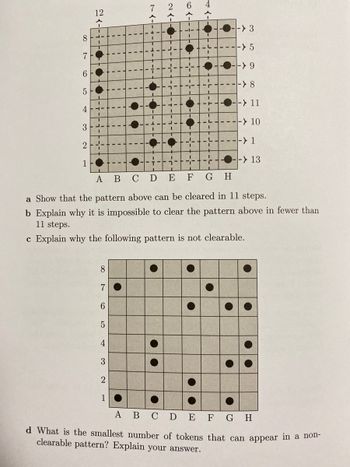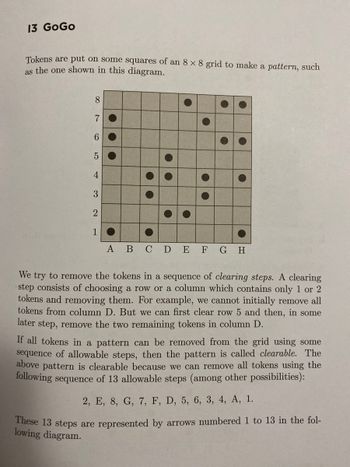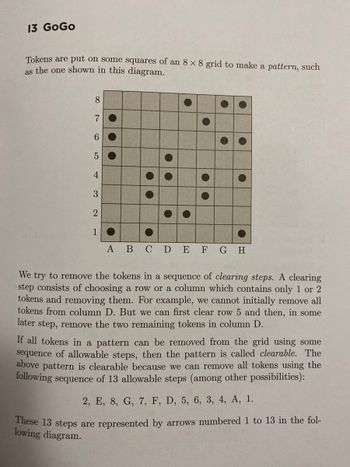
Advanced Engineering Mathematics
10th Edition
ISBN: 9780470458365
Author: Erwin Kreyszig
Publisher: Wiley, John & Sons, Incorporated
expand_more
expand_more
format_list_bulleted
Question

Transcribed Image Text:21-11-16
●
●
L-
8
7
6
5
4
3
I
2
1
--> 13
1
A B C D E
F
G H
a Show that the pattern above can be cleared in 11 steps.
b Explain why it is impossible to clear the pattern above in fewer than
11 steps.
c Explain why the following pattern is not clearable.
8
7
6
5
4
2
1
A B C D E F G H
d What is the smallest number of tokens that can appear in a non-
clearable pattern? Explain your answer.
I
2
I
I
6-
29
-> 3
-> 5
-> 9
----> 8
19
C
--> 11
----> 10
----> 1

Transcribed Image Text:13 GoGo
Tokens are put on some squares of an 8 x 8 grid to make a pattern, such
as the one shown in this diagram.
8
7
6
5
4
3
2
1
A B C D E F G H
We try to remove the tokens in a sequence of clearing steps. A clearing
step consists of choosing a row or a column which contains only 1 or 2
tokens and removing them. For example, we cannot initially remove all
tokens from column D. But we can first clear row 5 and then, in some
later step, remove the two remaining tokens in column D.
If all tokens in a pattern can be removed from the grid using some
sequence of allowable steps, then the pattern is called clearable. The
above pattern is clearable because we can remove all tokens using the
following sequence of 13 allowable steps (among other possibilities):
2, E, 8, G, 7, F, D, 5, 6, 3, 4, A, 1.
These 13 steps are represented by arrows numbered 1 to 13 in the fol-
lowing diagram.
O
.
P
C
A
C
Expert Solution
This question has been solved!
Explore an expertly crafted, step-by-step solution for a thorough understanding of key concepts.
This is a popular solution
Trending nowThis is a popular solution!
Step by stepSolved in 2 steps with 1 images

Follow-up Questions
Read through expert solutions to related follow-up questions below.
Follow-up Question
could you please explain how to do parts c. and d.

Transcribed Image Text:13 GoGo
Tokens are put on some squares of an 8 x 8 grid to make a pattern, such
as the one shown in this diagram.
8
7
6
5
4
3
2
1
A B C D E F G H
We try to remove the tokens in a sequence of clearing steps. A clearing
step consists of choosing a row or a column which contains only 1 or 2
tokens and removing them. For example, we cannot initially remove all
tokens from column D. But we can first clear row 5 and then, in some
later step, remove the two remaining tokens in column D.
If all tokens in a pattern can be removed from the grid using some
sequence of allowable steps, then the pattern is called clearable. The
above pattern is clearable because we can remove all tokens using the
following sequence of 13 allowable steps (among other possibilities):
2, E, 8, G, 7, F, D, 5, 6, 3, 4, A, 1.
These 13 steps are represented by arrows numbered 1 to 13 in the fol-
lowing diagram.
O
.
P
C
A
C
Solution
by Bartleby Expert
Follow-up Questions
Read through expert solutions to related follow-up questions below.
Follow-up Question
could you please explain how to do parts c. and d.

Transcribed Image Text:13 GoGo
Tokens are put on some squares of an 8 x 8 grid to make a pattern, such
as the one shown in this diagram.
8
7
6
5
4
3
2
1
A B C D E F G H
We try to remove the tokens in a sequence of clearing steps. A clearing
step consists of choosing a row or a column which contains only 1 or 2
tokens and removing them. For example, we cannot initially remove all
tokens from column D. But we can first clear row 5 and then, in some
later step, remove the two remaining tokens in column D.
If all tokens in a pattern can be removed from the grid using some
sequence of allowable steps, then the pattern is called clearable. The
above pattern is clearable because we can remove all tokens using the
following sequence of 13 allowable steps (among other possibilities):
2, E, 8, G, 7, F, D, 5, 6, 3, 4, A, 1.
These 13 steps are represented by arrows numbered 1 to 13 in the fol-
lowing diagram.
O
.
P
C
A
C
Solution
by Bartleby Expert
Knowledge Booster
Similar questions
- I'm struggling with variations! Scenario: You build a deck of cards from a collection. In the collection, there are 7x a cards and 8x b cards. What is the number of possible ways to choose 4 cards that are all a cards? The last time I asked this question it was all mushed up in a single line of text. Can you please separate the steps by 'enter' please and thank youarrow_forwardplease explain step by step, every concept in detailarrow_forwardYou are a thief overhearing someone's safe combination, which consists of a 5-digit number sequence. You are sure that the combination code contains at least two 6. How many codes would you have to potentially check to open the safe?arrow_forward
- Please answer all questionsarrow_forwardHow many ways can we climb a staircase with 8 steps if we can take either 1 or 2 steps at a time? Hint: Group the different ways according to the number of double steps.|arrow_forwardDuring the summer, a tourist plans to visit sixdifferent parks. She intends to visit each park onlyonce. She would like to plan the most efficientroute, and decides to list all the possible routes.How many different routes are possible?arrow_forward
arrow_back_ios
arrow_forward_ios
Recommended textbooks for you
 Advanced Engineering MathematicsAdvanced MathISBN:9780470458365Author:Erwin KreyszigPublisher:Wiley, John & Sons, Incorporated
Advanced Engineering MathematicsAdvanced MathISBN:9780470458365Author:Erwin KreyszigPublisher:Wiley, John & Sons, Incorporated Numerical Methods for EngineersAdvanced MathISBN:9780073397924Author:Steven C. Chapra Dr., Raymond P. CanalePublisher:McGraw-Hill Education
Numerical Methods for EngineersAdvanced MathISBN:9780073397924Author:Steven C. Chapra Dr., Raymond P. CanalePublisher:McGraw-Hill Education Introductory Mathematics for Engineering Applicat...Advanced MathISBN:9781118141809Author:Nathan KlingbeilPublisher:WILEY
Introductory Mathematics for Engineering Applicat...Advanced MathISBN:9781118141809Author:Nathan KlingbeilPublisher:WILEY Mathematics For Machine TechnologyAdvanced MathISBN:9781337798310Author:Peterson, John.Publisher:Cengage Learning,
Mathematics For Machine TechnologyAdvanced MathISBN:9781337798310Author:Peterson, John.Publisher:Cengage Learning,


Advanced Engineering Mathematics
Advanced Math
ISBN:9780470458365
Author:Erwin Kreyszig
Publisher:Wiley, John & Sons, Incorporated

Numerical Methods for Engineers
Advanced Math
ISBN:9780073397924
Author:Steven C. Chapra Dr., Raymond P. Canale
Publisher:McGraw-Hill Education

Introductory Mathematics for Engineering Applicat...
Advanced Math
ISBN:9781118141809
Author:Nathan Klingbeil
Publisher:WILEY

Mathematics For Machine Technology
Advanced Math
ISBN:9781337798310
Author:Peterson, John.
Publisher:Cengage Learning,

